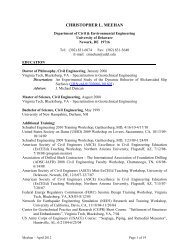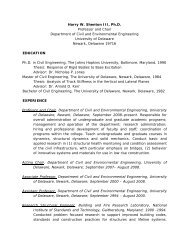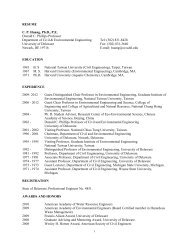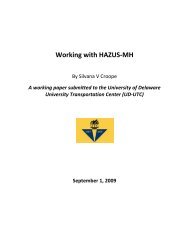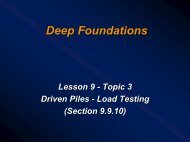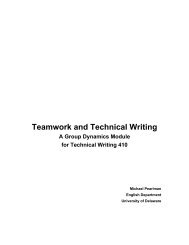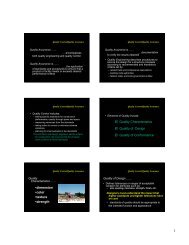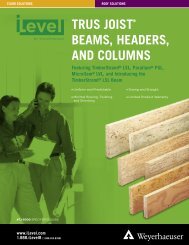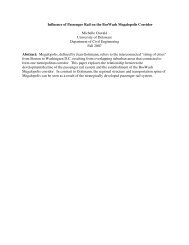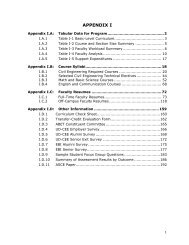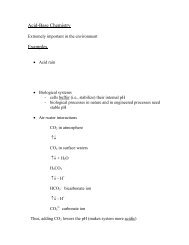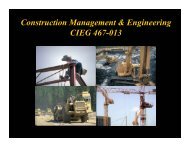ASTM C150
ASTM C150
ASTM C150
You also want an ePaper? Increase the reach of your titles
YUMPU automatically turns print PDFs into web optimized ePapers that Google loves.
Components<br />
Concrete<br />
• Portland Cement (<strong>ASTM</strong> <strong>C150</strong>)<br />
– Type I (normal) general purpose<br />
– Type II (modified) resistance to alkali attack<br />
– Type III (high early strength) high heat<br />
– Type IV (low heat) used for massive structures<br />
– Type V (sulfate-resistant) max. alkali resistance
Components<br />
• Aggregates<br />
Concrete<br />
– Coarse, fine, and lightweight<br />
– 60 to 80% volume of mix<br />
– Strong and durable<br />
– Resistant to freezing and thawing<br />
– Chemically stable (ASR)<br />
– Saturated surface-dry (SSD) optimum condition<br />
• Water<br />
– Potable, balanced pH, no organics or salts
Components<br />
• Admixtures<br />
– Air-entraining agent:<br />
• Greater resistance<br />
to freezing and<br />
thawing<br />
• Greater chemical<br />
resistance<br />
• Reduces<br />
permeability<br />
• Improved<br />
workability<br />
Concrete
Components<br />
• Admixtures<br />
– Water-reducing<br />
admixtures<br />
– Decrease water<br />
requirements<br />
without reducing<br />
workability<br />
Concrete
Concrete<br />
Components<br />
• Admixtures<br />
– Retarders<br />
• Slows the rate of hardening to increase<br />
working time<br />
– Accelerators<br />
• Increase the rate of hardening<br />
– Pozzolans<br />
• Used to replace some of PC with var. benefits<br />
– Plasticizers<br />
• Increases workability of the mix
Concrete<br />
Water-Reducing, Set-Controlling Admixtures<br />
<strong>ASTM</strong> C 494<br />
Type A Water-reducing admixtures<br />
Type B Retarding admixtures<br />
Type C Accelerating admixtures<br />
Type D Water-reducing & retarding admixtures<br />
Type E Water-reducing & accelerating admixtures
Concrete<br />
Mix Design<br />
• Water/cement ratio directly affects:<br />
– Compressive strength<br />
• High W/C ratio = lower strength<br />
• Low W/C ratio = higher strength<br />
– Durability<br />
– Workability or plasticity<br />
– Watertightness<br />
• Slump affects:<br />
– Workability or plasticity<br />
– Shrinkage
Mix Design<br />
Concrete<br />
• Cement, aggregates, and admixtures are<br />
produced according to <strong>ASTM</strong> specs<br />
• American Concrete Institute (ACI) provides<br />
guidelines for mix designs<br />
• Specifications refer to and incorporate <strong>ASTM</strong><br />
Specs and ACI guidelines
Mix Design<br />
Concrete<br />
Concrete specifications are generally based on<br />
one or more of the following:<br />
1. Mixture proportions designed and controlled by the<br />
owner<br />
2. Minimum cement content, max. water/cement ratio,<br />
and range of slump are specified<br />
3. Concrete strength specified @ 28 days
Paving and Surface<br />
Treatments<br />
• Paved surfaces include:<br />
– highways and local roads<br />
– airfield runways, taxiways, and aprons<br />
– parking lots and driveways<br />
– bridges<br />
– race tracks & recreational facilities<br />
– slope paving<br />
• Paved surfaces are generally rigid<br />
(PCC) or flexible (bituminous HMA)
• Surface treatments<br />
provide<br />
Paving and Surface<br />
– sealing or waterproofing<br />
existing pavements<br />
– bond new pavement to<br />
existing (tack coat)<br />
– wearing course for rural<br />
roads i.e.: tar and chip<br />
Treatments
Paving and Surface<br />
Treatments<br />
• Hotmix asphalt paving is generally placed in<br />
layers or lifts (base, binder, and wearing<br />
course)<br />
• Thickness of lift is in proportion to the<br />
aggregate size<br />
• HMA is placed with temperatures ranging 250°<br />
- 330° F<br />
• HMA must be placed on a firm, stable, welldraining<br />
base
Hotmix Paving<br />
Placing HMA<br />
• Confirm that base (GABC, recycled crushed<br />
concrete, or gravel mix) has been compacted to<br />
required density and is stable<br />
• Existing surfaces must be swept clean<br />
• Tack coat applied to existing surfaces at the rate<br />
specified (DelDOT = CSS-1-h at 0.2 gal/SY)<br />
• Tack is also applied to curb, gutters, manhole<br />
frames and other surfaces where bonding is<br />
required
Hotmix Paving<br />
Paving Equipment<br />
• Paver/Finisher spreads and<br />
provides initial compaction of<br />
hotmix<br />
• Must be able to compensate<br />
for minor grade irregularities,<br />
while forming crowns and<br />
superelevations<br />
• Must be able to travel on<br />
various types of surfaces and<br />
push dump trucks
Hotmix Paving<br />
Paver/Finisher<br />
• Paver/Finisher consists of a tractor unit<br />
and floating screed unit<br />
• Tractors are either wheel or track mounted<br />
• Tractor unit includes receiving hopper,<br />
feeders, distributing augers or spreader<br />
screws, power plant, transmission, dual<br />
controls, and operators seat
Hotmix Paving<br />
Paver/Finisher<br />
• The screed unit is attached to and towed by the<br />
tractor unit<br />
• The screed unit is attached to the tractor by long,<br />
pivoting screed arms<br />
• The screed forms and rides on the finished surface<br />
• Screed unit consists of a tamping bar or vibratory<br />
unit, thickness controls, crown controls, screed<br />
heater, and screed plate
Hotmix Paving
Hotmix Paving<br />
Paver/Finisher Operation<br />
1. Material is dumped into the hopper from a<br />
truck or conveyor unit<br />
• Rollers mounted on front of paver contact<br />
rear tires of truck<br />
• Paver pushes truck while it is dumping into<br />
the hopper<br />
• Truck drivers must be experienced in<br />
delivering hotmix
Hotmix Paving<br />
Paver/Finisher Operation<br />
2. Two independently controlled bar feeders<br />
carry mix through control gates to spreader<br />
screws<br />
• Each spreading screw is synchronized to its<br />
feeder<br />
• Operator can control distribution of mix in front<br />
of the screed unit
Hotmix Paving<br />
Paver/Finisher Operation<br />
3. Screed unit is pulled by the tractor across the<br />
material and adjusted to produce the desired<br />
thickness<br />
• The screed is equipped with a heater to prevent<br />
the material from sticking to the screed plate<br />
• The tamper bar or vibrating screed strikes-off<br />
and provides the initial compaction<br />
• Screed units can be set for precise thickness,<br />
crown, and superelevation
Hotmix Paving<br />
Paver/Finisher Operation<br />
• Paver/finishers are capable of self-leveling<br />
– Minor base irregularities are eliminated<br />
– Screed bottom rides parallel with the direction of pull<br />
• Mat thickness is set by the thickness controls on<br />
the screed<br />
– Irregularity in the base causes machine to automatically<br />
increase/decrease thickness to compensate<br />
– Thickness changes at the screed board are not abrupt,<br />
but slowly inclining or declining until the new thickness<br />
has been reached
Hotmix Paving<br />
Paver/Finisher Operation<br />
• Screed width can be increased or decreased<br />
by hydraulic telescoping extensions<br />
• Automatic feeder controls are moved<br />
outward with the extensions<br />
• Control of screed level can be manual,<br />
semiautomatic, or fully automatic<br />
• Automatic screed controls include jointmatching<br />
shoe, string line to grade, and long<br />
ski
Hotmix Paving<br />
Paver/Finisher Operation<br />
• Joint-matching shoe senses surface grade<br />
and sends information to the electronic<br />
control system<br />
– Used to match adjacent pavement or gutter<br />
grade or maintain thickness over a previous<br />
course<br />
• String line to grade system – not used often
Hotmix Paving<br />
Paver/Finisher Operation<br />
• Long ski automatic grade control system<br />
– Semi-rigid boom or floating beam<br />
– Serves as a floating grade reference connected<br />
to the electronic sensing and control system<br />
– Averages out longitudinal errors and<br />
irregularities of the surface being paved<br />
– Used generally for surface course or nearsurface<br />
binder course
Paver/Finisher Operation<br />
• Pavers are also<br />
equipped with<br />
automatic transverse<br />
slope control<br />
Hotmix Paving
Hotmix Paving<br />
Crew Requirements<br />
• Paving crew size and composition can vary<br />
depending upon:<br />
– desired production rates<br />
– lift thickness<br />
– amount of handwork<br />
– job conditions<br />
– Union labor contract or agreements
Hotmix Paving<br />
Crew Requirements<br />
Basic crew composition and function include:<br />
• Foreman<br />
– Estimates and orders required material and tack<br />
– Determines labor, equipment, fuel, and<br />
maintenance requirements<br />
– Plans actual paving operation i.e.: number of<br />
trucks, paving sequence, direction of pulls, etc<br />
• Front-line supervisor responsible for quality,<br />
production, and safety
Crew Requirements<br />
• Paver Operator<br />
Hotmix Paving<br />
– Controls paver direction and speed<br />
– Controls hopper and feeders<br />
– Checks and controls overall machine operation<br />
• Screedman<br />
– Controls thickness, width, and cross slope of mat<br />
– Must understand grades and machine operation<br />
and behavior
Crew Requirements<br />
• Dump man<br />
Hotmix Paving<br />
– Coordinates and directs truck driver movements<br />
and dumping<br />
– Aids truck drivers in obstructed view situations or<br />
aerial hazards<br />
– Collects material delivery tickets<br />
• Shovel man<br />
– Manual distribution of material as needed
Crew Requirements<br />
• Rake or “Lute” man<br />
Hotmix Paving<br />
– Rakes edges or joints to assure tight, smooth<br />
seams<br />
– Finishes areas not accessible to the paver or<br />
screed (handwork)<br />
– Skill position that requires experience and<br />
finesse
Crew Requirements<br />
• Roller Operator(s)<br />
Hotmix Paving<br />
– Multiple operators are usually required for<br />
breakdown, intermediate, and finish roller<br />
operations<br />
• Lab technician<br />
– Owner’s inspector or contractor’s QA/QC<br />
technician (on performance spec contracts)<br />
verifying density
Hotmix Paving<br />
• The paving machine is preheated prior to paving<br />
and the grade controls are checked and set<br />
• The screed board is set to a height that upon<br />
compaction will yield the desired lift thickness<br />
• Compaction is performed by steel drum watercooled<br />
rollers<br />
• Roller(s) completes initial breakdown passes<br />
• Intermediate rolling essentially completes<br />
compaction<br />
• Finish or cold rolling removes creases and final<br />
sealing
Hotmix Paving<br />
• Rolling patterns (number of passes) is obtained by<br />
control strip that determines the target density<br />
• Base courses are compacted to 90% lab density<br />
• Wearing courses (top) are compacted to 95%.<br />
• Rolling should initiate at the curb line in the<br />
longitudinal direction overlapping the previous<br />
pass by at least half of the roller width<br />
• Alternate length of passes to avoid changing<br />
direction at the same location<br />
• Longitudinal joints or seams should be “pinched”<br />
by rolling directly behind the paving operation
Hotmix Paving<br />
• Roller speed should be slow and uniform, avoiding<br />
sudden stops<br />
• Idle rollers should stay only where the mat has<br />
cooled sufficiently<br />
• Superpave mixes have much narrower temperature<br />
ranges for compaction<br />
• “Tender zone”<br />
• Various other polymer, SMA, and open-graded<br />
mixes have special rolling requirements, and behave<br />
differently than conventional mixes
Hotmix Paving<br />
• Minimum ambient temperature requirements:<br />
– 32°F for base courses > 2”<br />
– 40°F for base, binder, or wearing course ≤ 2”<br />
– 50°F for wearing or surface courses ≤ 1”<br />
– 60° to 65°F for open-graded and certain polymer surface<br />
courses<br />
• Succeeding course should not be placed until the<br />
previous course has cooled to < 140°F<br />
• Traffic should not be allowed on pavement until the<br />
surface temperature has cooled to < 140°F
Hotmix Paving<br />
• Tack must be applied to new pavement surfaces<br />
immediately prior to the next lift when:<br />
– 10 days have elapsed<br />
– it has rained since placing the last lift<br />
– the surface has become dirty<br />
• Tie-ins to adjoining (existing) pavements must be saw<br />
cut (transversely) to provide a clean vertical joint<br />
• Tie-in smoothness is enhanced by cutting transverse<br />
“butt joints”<br />
• Hotmix used to overlay concrete can be saw cut &<br />
sealed over the concrete joints to prevent reflective<br />
cracking
Hotmix Paving<br />
Pavement Rehabilitation<br />
• Periodic pavement rehab can be a cost effective<br />
means of extending the service life<br />
• Existing surface course is removed by rotomilling<br />
(a.k.a. milling or planing)<br />
• The base is patched as necessary<br />
• Manhole and inlet frames are adjusted to new<br />
grades as required<br />
• New butt joints are cut<br />
• Surface is cleaned, tacked, and overlaid with a new<br />
wearing course (top)
Pavers working in<br />
Echelon (tandem)<br />
• Elimination of cold<br />
joint<br />
• High capacity and<br />
production operation<br />
Hotmix Paving
Hotmix Paving<br />
Mobile conveyor<br />
• Material handler receives<br />
material from trucks and<br />
conveys to paver resulting<br />
in:<br />
1. Increased paver<br />
production<br />
2. Nonstop paving<br />
operation<br />
3. In-line or offset paving<br />
4. Reduced hauling cost<br />
and time wasted at the<br />
paver
Keys to Successful Hotmix<br />
Paving<br />
• Employ well-trained, experienced personnel i.e.<br />
foreman, operators, laborers (especially lute man!)<br />
• Good grade control (survey function)<br />
• Thorough understanding of the paving equipment and<br />
and electronic control systems<br />
• Good mix design and production<br />
• Quality control in the plant and field<br />
• Desire to produce a high quality, smooth, and durable<br />
pavement
Concrete Pavement<br />
• Rigid pavement placed on a stone (GABC), soil<br />
cement, or permeable treated base (asphalt or PCC)<br />
• Placed using fixed forms or slipform<br />
• Crew requirements depend on method of placement<br />
• Modern practice is to place un-reinforced concrete<br />
with close control joint spacing @ 15’<br />
• Smooth dowel bars usually spaced 12” o.c. are used<br />
at joints to transfer the load across the joint and<br />
provide shear strength<br />
• Bars or hook bolts are used to connect slabs<br />
longitudinally
Concrete Pavement<br />
• Fixed-form placement can<br />
employee any number of<br />
mechanical form riding<br />
equipment<br />
• Equipment is used to spread,<br />
strike off (screed),<br />
consolidate, and finish<br />
concrete<br />
• Concrete is usually delivered<br />
and placed by mixer trucks
Concrete Pavement<br />
• Placement can be by<br />
conveying equipment<br />
• Some finishing is usually<br />
completed by hand<br />
– floats and trowels along<br />
the edges<br />
– straight edge “bump<br />
cutters” and bull floats<br />
transversely across the<br />
slab
Concrete Pavement<br />
Slipform Paving<br />
• No forms used to contain the sides of the slab<br />
• Grade and alignment control is by string line followed<br />
by electronic sensors mounted on the machine<br />
• Paving train operation employees single or multiple<br />
machines for placement and distribution, forming,<br />
consolidation, and finishing<br />
• State-of-the-art equipment has self-contained dowel<br />
bar and longitudinal bar inserters<br />
• Concrete is usually hauled in dump trucks at a very<br />
low slump, typically 1”±
Concrete Pavement<br />
• Concrete is placed directly on the grade in front<br />
of the paving train or into a belt placer<br />
(conveying machine)<br />
• Slipform strikes off and consolidates the<br />
concrete<br />
• Minimal hand finishing is generally required<br />
(bump cutter and bull float)
Concrete Pavement<br />
• Automated or manual<br />
texturing using steel tines<br />
to form groves<br />
transversely across the<br />
pavement<br />
• Tines are 1/8” to 3/16”<br />
wide x 3/16” deep<br />
• Transverse grooving by<br />
saw cutting can be<br />
performed after concrete<br />
has cured
Concrete Pavement<br />
• Pavement is then sprayed with curing<br />
compound to prevent rapid evaporation<br />
• Saw cutting at transverse joints must be done<br />
as soon as the concrete can be cut without<br />
excessive damage to the slab i.e. spalling,<br />
tearing, rutting, or washing away mortar<br />
• Saw cutting depth is typically T/4 to T/3<br />
• Upon completion of the paving and curing<br />
period, these joints are widened and sealed
Concrete Pavement<br />
Pavement Smoothness<br />
• Performance spec regarding pavement smoothness<br />
• Devices for measuring smoothness include:<br />
– 10’ straight edge<br />
– rolling straight edge<br />
– computerized California type Profilograph<br />
• Profilograph measures the cumulative bumps per<br />
tenth of a mile (528’) and provides a Profile Ride Index<br />
(PRI) in bumps per mile
Concrete Pavement<br />
• Profilograph locates and<br />
records bumps or dips ><br />
0.3” in height<br />
• Specs stipulate<br />
acceptable PRI ranges<br />
• Bonus/penalties can be<br />
assessed for the various<br />
ranges<br />
• Diamond grinding is done<br />
to correct roughness
Keys to Successful<br />
Concrete Paving<br />
• Good grade control<br />
• Proper selection and maintenance of<br />
equipment<br />
• Consistent mix i.e. slump, air%, delivery rate<br />
• Qualified supervision, operators, and finishers<br />
• Steady, continuous paving operation<br />
• Stable base grade (wet prior to paving)<br />
• Desire to produce a high quality, smooth, and<br />
durable pavement
Bridge Construction
Bridge Construction<br />
Classification of bridge by:<br />
• Function<br />
• Span Length<br />
• Span Type<br />
• Structure Materials<br />
• Cross Section<br />
• Degree of Redundancy<br />
• Floor System<br />
• New or Rehab
Superstructure<br />
Bridge Components<br />
a. Floor Beams<br />
b. Girders<br />
c. Stringers<br />
d. Diaphragms<br />
1) Intermediate<br />
2) End<br />
3) Continuity (concrete)
Bridge Components<br />
Superstructure<br />
e. Deck<br />
1) Roadway & shoulder<br />
2) Sidewalk/overhang<br />
f. Parapet and railings<br />
g. Expansion dams
Bridge Components<br />
h. Truss members<br />
1) Chords (top & bottom)<br />
2) Vertical & diagonal web members<br />
3) Lateral bracing<br />
4) Portal<br />
5) End post<br />
i. Struts & wind bracing system<br />
j. Cable system<br />
k. Hangers – fixed and expansion
Bridge Construction<br />
Superstructure Erection Techniques<br />
a. On falsework<br />
b. By cantilevering<br />
c. Hoisting into position<br />
d. Rolling or sliding into position<br />
e. Floating into position<br />
f. Suspension erection<br />
g. Segmental construction<br />
h. Combination of two or more techniques
Bridge Construction<br />
Factors involved in determining method<br />
of superstructure erection<br />
a. Condition of the river or stream bed<br />
b. Amount of interference to/from navigation<br />
c. Interference from railroad and vehicular<br />
traffic<br />
d. Water depth<br />
e. Stream current<br />
f. Presence of driftwood, ice, etc.
Bridge Construction<br />
Factors involved in determining method<br />
of superstructure erection<br />
g. Bridge height<br />
h. Utility conflicts<br />
i. Physical constraints imposed by adjacent<br />
structures, facilities, wetlands, parklands,<br />
etc.<br />
j. Locally available equipment<br />
k. Contractor’s resources and preferences
Substructure<br />
Bridge Components<br />
a. Abutments<br />
1) Breastwall<br />
2) Wingwalls<br />
3) Bridge seat<br />
4) Backwall<br />
5) Footing or pile cap
Substructure<br />
b. Piers<br />
Bridge Components<br />
1) Stem wall<br />
2) Column or pier<br />
shaft<br />
3) Web wall<br />
4) Pier cap<br />
5) Footing or pile cap
Substructure<br />
Bridge Components<br />
c. Pile bent<br />
1) Piles (steel, concrete,<br />
or timber)<br />
2) Bent cap<br />
d. Caisson<br />
e. Piling<br />
f. Dolphins and fenders<br />
g. Cofferdams
Bridge Construction<br />
Substructure construction details<br />
a. Modular formwork using “gang forms” placed<br />
by crane<br />
b. Forms include outriggers for scaffolding<br />
c. Vinyl form liners used to provide texture,<br />
brick/stone patterns, fins/ribs, etc<br />
d. Chamfer should be used at all corners and<br />
edges, and at construction joints<br />
e. Concrete surface treatments include siliconbased<br />
waterproofing and epoxy protective<br />
coating
Bridge Construction<br />
Substructure construction techniques<br />
a. Concrete placed by crane and bucket or<br />
pumped<br />
b. Pumping affects the air% and slump<br />
c. Superplasticizers used in concrete to maximize<br />
flow around tight rebar configurations i.e.: spiral<br />
wrapped columns and heavily reinforced caps<br />
(form design must consider full liquid head)
Bridge Components<br />
Bearings<br />
• Fixed or expansion<br />
• Referred to as “shoes”<br />
• Steel, bronze, neoprene<br />
• Rocker, roller, spherical, and<br />
elastomeric<br />
• New or retrofit<br />
• Masonry plate, sole plate
Bridge Components<br />
Substructure Alternatives<br />
• Mechanically Stabilized Earth Walls<br />
– Used in place of conventional CIP concrete<br />
– Used with pile supported stub abutments<br />
eliminates need for breast wall<br />
• Piles are driven prior to placing<br />
embankment and isolated with sleeves<br />
• MSE walls and soil reinforcement are<br />
installed after sleeves are installed<br />
• Pile cap serves as bridge seat and MSE<br />
wall coping
Bridge Components<br />
MSE Walls – two<br />
major systems<br />
1 Reinforced<br />
Earth Walls by<br />
RECO<br />
2 Retained Earth<br />
Walls by Foster<br />
Geotechnical<br />
(formerly VSL)
Bridge Rehabilitation<br />
Typical Work Elements<br />
• Deck patching or replacement<br />
• Latex modified concrete or micro-silica overlay<br />
• Bearing retrofit/replacement, cleaning,<br />
lubricating<br />
• Expansion dam and seal replacement<br />
• Parapet/barrier modification<br />
• Substructure repair by patching spalls, pressure<br />
injection of cracks, and waterproofing<br />
• Painting (including removal of old paint systems)
Bridge Construction<br />
Safety<br />
• OSHA has adopted strict<br />
new regulations<br />
regarding fall protection<br />
• Fall arrest protection<br />
including harness -safety<br />
belts are no longer<br />
permitted<br />
• PPE includes life jackets<br />
when working over or<br />
adjacent to water
Bridge Construction<br />
Submittals<br />
• Submittal requirements generally include shop<br />
drawings for:<br />
– all formwork, falsework, containment systems,<br />
shoring<br />
– erection plans/procedures, dewatering, staging<br />
– fabricated and precast items, embedded items,<br />
and rebar<br />
– Material certification for everything incorporated<br />
into the final structure<br />
• Submittals must include design calculations when<br />
applicable
Bridge Construction<br />
Current and Future Trends<br />
• Bridge Management programs include periodic<br />
condition inspection and rating of existing<br />
structures<br />
• Many existing bridges are structurally deficient or<br />
functionally obsolete, and require replacement or<br />
rehabilitation ∴<br />
– More rehab/retrofit/replacement<br />
– fewer new structures on new alignment<br />
• Increase use of high strength steel in hybrid<br />
girders greatly reducing dead load
Bridge Construction<br />
Current and Future Trends<br />
• Expanding use and improvement of PS/PC<br />
concrete<br />
• Growing use of segmental construction<br />
• More sophisticated design software will enable<br />
designers to push the envelop<br />
• Use of moisture-cured painting systems<br />
• Use of composite construction techniques<br />
• Use of composite materials<br />
• Installation of noise barriers
Bridge Construction<br />
Current and Future Trends<br />
• Greater emphasis on aesthetics to include:<br />
– Context sensitive design<br />
– More public input in T.S. & L., materials, timing,<br />
and final appearance<br />
– Architectural input<br />
• Addition of lighting for safety and appearance<br />
• Demand for increased deck smoothness<br />
• More stringent OSHA requirements
Bridge Construction

